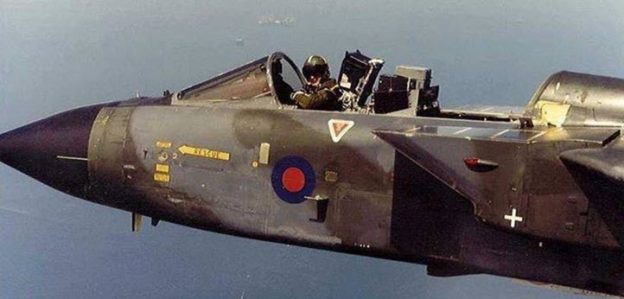Source: ‚The aviation geek Club (Text) and BAE Heritage Collection / Kate Yates‚ (Image).
Taken in 1988 the unique photos in this post feature British Aerospace (BAe) Test Pilot Keith Hartley conducting the ‘cockpit habitability trial’ in his open-top Tornado XZ630. “In 1988, our test pilot Keith Hartley flew at 500 knots in a Tornado aircraft with the canopy off, testing the emergency escape procedures of the jet; just one example of the lengths we go to test the safety of the planes we build for the RAF.”
The Panavia Tornado XZ630 was the first British pre-production aircraft which flew on March 14, 1977 and participated in weapons release trials at the Aeroplane & Armament Experimental Establishment (A&AEE) at Boscombe Down. Noteworthy Pre-production Tornados incorporated a number of refinements over earlier prototypes that would be incorporated onto production aircraft.
Former Lightning and Tornado F3 pilot Ian Black said: “While the first ten aircraft could be considered true prototypes, the first real Tornado for the RAF flew in March 1977 (XZ630) and it was quickly assigned to the A&AEE at RAF Boscombe Down in Wiltshire.”
After a successful career as a trials aircraft, Panavia Tornado XZ630 was retired to ground duties and has been the Gate Guardian at RAF Halton’s Recruit Training Squadron Parade Square since 2004. It was refurbished to resemble a GR4 from 31 Squadron, currently based at RAF Marham, and known as the ‘Goldstars’. The refurbishment was carried out by Serco contractors.
Development of the Tornado began in 1968, when the United Kingdom, West Germany and Italy initiated a collaborative project to produce a low-level, supersonic aircraft. Panavia Aircraft, a new tri-national company established in Germany, built the variable-sweep wing aircraft, and the first prototype flew on Aug. 14, 1974.
Tornado has been a vital part of air forces from the day it went into service in 1979: With a max speed of 1.3 Mach and an expansive range of integrated weaponry the Tornado is a formidable aircraft that is renowned for its ability to operate in any weather conditions, at low level at any time of the day or night. The Tornado was exported to the Royal Saudi Air Force and is still in use by them today.
Diesen Beitrag teilen mit:
Gefällt mir:
Gefällt mir Wird geladen …




